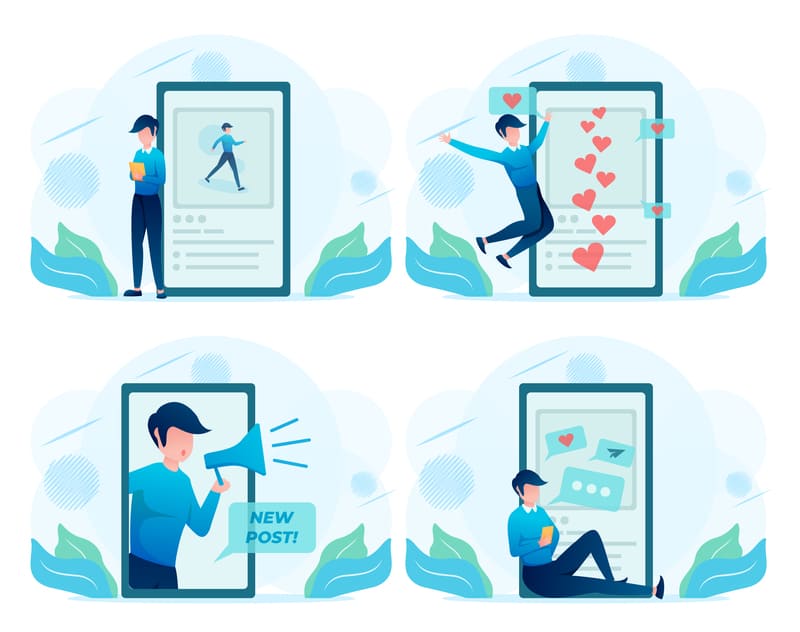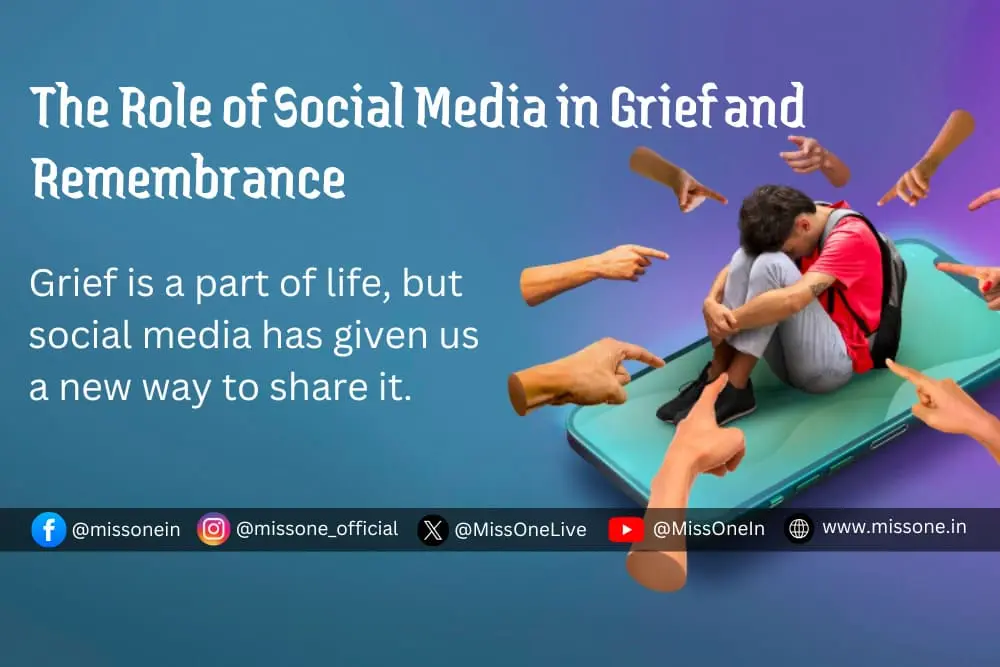When I lost my nani last year, I didn’t know where to put all the sadness. The house felt empty without her chattering about old Bollywood songs or scolding me for not eating enough ghee on my paratha. I cried, I sat quietly, but something was missing. Then, one night, I posted a picture of her on Instagram her smiling in her favourite red saree with a caption about how she’d always be my hero.
Within minutes, my phone buzzed with messages. Friends, cousins, even people I hadn’t spoken to in years, poured in with “RIP” and heart emojis. That’s when I realised social media isn’t just about selfies and reels. It’s become a space where we Indians grieve, remember, and heal together.
Today, let’s talk about how platforms like Facebook, Instagram, WhatsApp, and Twitter (or X, as they call it now) are changing the way we deal with loss and keep memories alive. This isn’t just a tech thing it’s personal, emotional, and so very Indian in its own way.
Social Media: A New Kind of Shok Sabha
In India, when someone passes away, we’ve always had our traditions. The shok sabha, the prayer meets, the relatives gathering to mourn, it’s how we’ve said goodbye for generations. But ab zamana badal gaya hai. People are busy, families are scattered across cities or even countries. My cousin in Canada couldn’t come for Nani’s antim sanskar, but she saw my post, cried with me over a video call, and shared her own memory on her story.
Social media has become our digital shok sabha. You don’t need to be in the same room anymore to mourn together. A simple “Rest in Peace” comment or a WhatsApp status with a candle emoji connects us when distance keeps us apart. For Indians, who are so rooted in family and community, this is a big deal. We’re emotional people we need to share our dukh, and these platforms let us do that, instantly.
Think about it. Earlier, if someone passed away, the news spread through phone calls or word of mouth. Now? One post on Facebook, and within hours, hundreds of people know. They leave messages, share prayers, or just drop a “Om Shanti.” It’s like the whole world becomes your family for a moment.
You may like: Remembering Loved Ones in the Digital Age
Keeping Memories Alive, One Post at a Time
Ek baat toh hai – we Indians love holding onto yaadein. Whether it’s keeping Papa’s old watch or Ma’s handwritten recipe book, we don’t let go easily. Social media has taken this love for remembrance to another level. Now, we don’t just store memories in photo albums that gather dust on shelves. We put them online, where they live forever.
I’ve seen people create Facebook pages for loved ones who’ve passed away. My friend Priya lost her brother in a road accident two years ago. She made a page called “In Memory of Rohan” and posted pictures, videos, even his goofy WhatsApp forwards. Every year on his birthday, she writes him a message there. “Bhai, aaj tu hota toh cake pe ladai hoti,” she wrote last month. Friends comment, share their own stories, and it’s like Rohan is still part of the gang.
This isn’t just Priya’s story it’s happening everywhere. People tag the departed in posts, wish them on anniversaries, or share throwback photos with captions like “Miss you every day.” It’s our way of saying, “Tum chale gaye, par dil se nahi gaye.” Social media gives us a space to keep talking to them, even when they’re not here.
The Good Side: Healing Through Sharing
Grief can feel like a heavy stone on your chest. In India, we’re taught to stay strong “Rona kamzori hai,” they say. But bottling it up? That’s even harder. Social media has become a safe corner where we can let it out. When I posted about Nani, I wasn’t expecting much. But reading those comments “She was such a beautiful soul” or “I remember her pakodas” made me smile through the tears. It reminded me I wasn’t alone.
For many Indians, especially the younger lot, typing out feelings is easier than saying them aloud. You don’t have to face anyone’s pitying looks or awkward silences. You just write, post, and let the love come back to you. Psychologists bhi yeh kehte hain sharing grief helps you process it. And in a country where mental health talks are still taboo, this is a quiet revolution.
Then there’s the support. When my uncle passed away, someone started a WhatsApp group to coordinate help food for the family, updates on the cremation, even a crowdfunding link for his kids’ education. In minutes, people chipped in. That’s the desi spirit we rally around each other, and social media makes it faster and bigger.

The Not-So-Good Side: When It Gets Messy
Par har cheez ka ek doosra pehlu hota hai, na? Social media isn’t always a blessing in grief. Sometimes, it feels like a drama stage. I’ve seen people post crying selfies with captions like “Why did you leave me?” and then get annoyed if they don’t get enough likes. It’s like they’re performing their sadness for an audience. Yeh dil se nahi, dikhawa lagta hai.
And then there’s the trolling. Last year, a celebrity’s death flooded Twitter with RIP posts, but also with cruel jokes and fights over “who’s sadder.” For families already hurting, this can feel like salt on wounds. Imagine scrolling through memories of your loved one and stumbling on “He deserved it” from some random stranger. Dil toot jata hai.
Privacy bhi ek issue hai. In India, we’re still figuring out how much to share. My chachi once got upset because someone posted pics of my uncle’s funeral without asking. “Yeh personal tha,” she said, and she was right. Not everyone wants their grief to be a public tamasha.
WhatsApp: The Desi King of Grief
If there’s one app that rules how we Indians grieve, it’s WhatsApp. Arre, yeh toh hamara lifeline hai! When someone passes, the family group lights up with messages “Shocking news,” “Prayers for the soul,” “Call me when you’re free.” Forwards start pouring in shlokas from the Gita, pictures of gods with “Om Shanti” written in red. My mausi even sent a 10-minute voice note sobbing and reminiscing, and we all listened, cried, and replied with “Haan, yaad hai.”
WhatsApp is where the real, raw emotions come out. It’s not polished like Instagram or public like Facebook. It’s personal, like a family chaupal. And those status updates? A black square, a diya, or “Miss you Papa” they say so much in so little.
How It’s Changing Our Traditions
Social media isn’t replacing our sanskaras, but it’s adding to them. Take the tehrvi the 13th-day ritual after a death. Now, people live-stream it on Zoom or YouTube so relatives abroad can join. During the pandemic, when we couldn’t gather, my neighbour’s family shared a Google Drive link with videos of the prayers. It’s practical, yes, but it also keeps us connected.
Even the way we remember is evolving. Earlier, we’d light a diya or visit a mandir on someone’s death anniversary. Now, we also post a tribute online. It’s like a modern shraddhanjali – less formal, more heartfelt. And for the younger generation, who might not know all the rituals, this feels natural.
A Space for Everyone
One beautiful thing about social media? It’s not just for the tech-savvy. My dadaji, who’s 78, doesn’t know how to tweet, but he watches every video I post about Nani on WhatsApp. He’ll call me later, voice shaky, saying, “Beta, uski aawaz yaad aa gayi.” It’s a bridge between generations, between the old ways and the new.
For women, especially in smaller towns, it’s even bigger. They might not always get to speak up in traditional settings, but on social media, they can share their grief, their stories. My friend’s mom, a quiet homemaker, wrote a long post about her sister’s death on Facebook. “Pehli baar laga main bhi kuch keh sakti hoon,” she told me. That’s power, right there.
The Future: What’s Next?
As an Indian, I feel social media will only get deeper into our grief and remembrance. Maybe we’ll see virtual memorials with VR headsets, where you can “visit” your loved ones. Or AI bots that reply like them creepy, but also comforting? For now, it’s about posts, stories, and statuses, but the heart of it won’t change. We’ll keep finding ways to say, “Tum yaad rahe.”
Final Thoughts
Social media isn’t perfect. It can be loud, messy, and sometimes fake. But it’s also a shoulder to cry on, a diary to write in, a photo frame that never fades. For us Indians, it’s become a part of how we grieve and remember a mix of our sanskriti and the digital duniya.
So, next time you see an “RIP” post or a WhatsApp status with a diya, pause for a second. It’s not just a click. It’s someone’s heart reaching out, asking to be heard, asking to keep a memory alive. And in that moment, we’re all connected through tears, through love, through the screens in our hands.
What do you think? How has social media touched your grief or your memories? Share karo after all, baat dil se dil tak jati hai.

